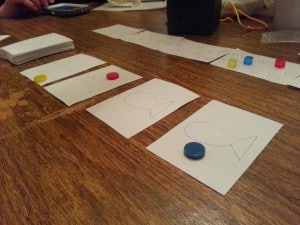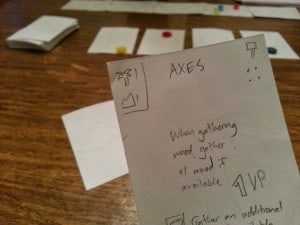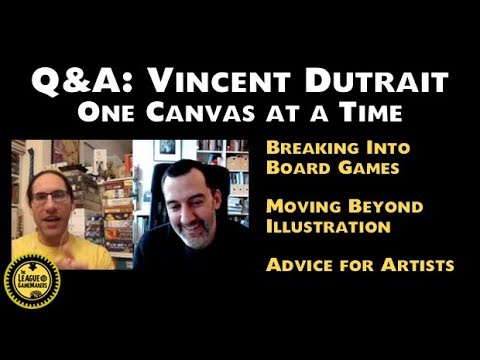
Part 2 of a 3 part series on the DFWNN Design competition – perspectives from two League of Gamemakers design teams!
—
We are two weeks into the DFW Nerd Night Game Design Contest! In this part 2 of my coverage of this contest, I’ll share our process through significant changes in the design. As in Part 1 of this 3 part series, you can also see Jasmine Davis’s design vlogs from this same contest by scrolling down.
A MAJOR CHANGE
After initial play tests of our Polynesian themed resource management and civilization building game, we liked some of it, but hated other parts. We brainstormed ways to fix what wasn’t fun – to fix some problems and hang-ups. But we have been very conscious of not OD’ing on this game. That is, we didn’t want to over design.
So you know where we were coming from, we had the idea to create a board from throwing cards randomly into the center of the table. Wherever they landed would be the board. We then had pieces that would move around the board with the edge of a card acting as a measuring tool. Lines along the edge marked how far you could go in one turn, and development cards would help you go further as the game progressed. Upon reaching a card, you could gather whatever resource was available on that card. After taking an action to send the resources “home” you could build developments. Developments gave abilities and victory points. At the end of the game, the player with the most VP won.
We identified three major problems:
- Keeping the tension. We couldn’t fix how to resolve the conflict of two players being on the same card. We wanted a way to attack each other or at least interact. Also, our main built-in tension in the game was what I referred to in my previous post – sending tropical storms to decrease supply and prevent hoarding cards. Well, how these storms showed up was difficult. Since we had our four resources in separate decks, we put one storm in each deck, too. But, we realized that once a storm came up in a deck, that deck now felt “safe” and the tension was gone.
- We didn’t know how to end the game. Trust me, playing until you find an ending is not successful. We tried. Also, we thought of ending the game when all four storms had come up, but in that case, once three storms happened, everyone would know where the last storm was and just avoid that deck to postpone ending the game.
- Respecting the theme.Thematically, it felt like if your canoe was out gathering resources, and it took time to get to those resources, it should logically take time to get those resources home before you build with them. But keeping “canoe resources” separate from “home resources” was a pain. In trying to respect the integrity of the theme, we found ourselves adding rules and adding more stuff to do.
The more we tried to fix, the more we just kept adding on and the more rules we had to come up with. Our game was getting fat on an over-designing diet of problems smothered in bad mechanics.
In order to cut the fat, we re-examined what our design landmark should and could be. We quickly realized that this would require a major change in design in order for the design landmark to stand out.
OUR DESIGN LANDMARK
As I have said in about every article I’ve written since first hearing this advice, we focused our efforts on what is fun about the game. We decided what was fun mechanically and thematically about the game.
What was fun:
- Mechanically:
 The decision making required by our double-sided resource cards. Our favorite part of this design is and has been from the beginning, a new mechanic to us. Because of the limitations of this component driven contest, we are limited to the 75 cards that came in the prototype kit. So, to maximize the use of the cards, our cards do double duty. Each resource card has a development option on the back. For example, on the back of a few of the wood resource cards is an axe. You need to collect one wood and one stone to build the axe. Once the axe is built, you can gather an additional wood on your turn. Or, you forget the axe and use the card as one wood to build something else. The decision making involved in determining what developments to build and what developments to give up in order to use the resource is really fun.
The decision making required by our double-sided resource cards. Our favorite part of this design is and has been from the beginning, a new mechanic to us. Because of the limitations of this component driven contest, we are limited to the 75 cards that came in the prototype kit. So, to maximize the use of the cards, our cards do double duty. Each resource card has a development option on the back. For example, on the back of a few of the wood resource cards is an axe. You need to collect one wood and one stone to build the axe. Once the axe is built, you can gather an additional wood on your turn. Or, you forget the axe and use the card as one wood to build something else. The decision making involved in determining what developments to build and what developments to give up in order to use the resource is really fun. - Thematically: Building a unique society. What is fun about the game is watching the society come together. Building developments and deciding what to build to maximize points and efficiency is fun. We enjoyed looking at what kind of society we were putting together based on what we were deciding to build.
When we realized what was fun about the game, we realized we had found our design landmark.
Once we knew what we needed to keep, it was time to decide what to trash. And I can tell you right now that using actions to move a player piece and send resources home was not fun. Acknowledging that it wasn’t fun made it easy to cut it out. Slim the design down. And that can be hard to do –
ADMIT THAT SOMETHING YOU DESIGNED ISN’T FUN.
But it’s necessary. What’s funny about cutting that part of the game is that by taking out the board, we took out our initial inspiration for the game. Throwing out cards randomly was what gave us the theme idea of Polynesia – the scattered cards looked like scattered islands. But, we had to say “Thank you and good-bye” to our board, and the game is all the better for it. After deciding to cut the board idea completely, the rest of the changes flowed organically. All of the problems from the initial play test seemed to vanish as a clean and smooth mechanically driven game came out of the ashes.
- Keeping the tension. We combined all the separate resource decks into one. With that, the four “storm” cards are shuffled into the one deck. These are re-themed “Omen” cards and after four Omens appear in the game, the game is over. The tension is built over not knowing when an Omen is coming, or how that Omen would affect your game. And the tension never lets up.
- We didn’t know how to end the game. Ending the game after four Omens works when the cards are all in one deck. Because players always take at least one card on every turn, the deck will always dwindle until all four Omens have appeared. The game ends itself!
- Respecting the theme. By removing the board, and focusing on the mechanic being the star of the show, the issues with theme all but evaporated. Theme is still informing our decisions as we write out cards. But, by allowing the game to be a little more abstract working with just cards, and removing any time and space from the game, the theme is happier and so are we.
NOT JUST A CARD GAME
 You might notice that if we took out the board, and the player pieces moving on the board, we’re basically left with a card game. Since this is a contest to use components given to us, we were very concerned with using more components than just the cards. We had decided to combine all the resources into one deck. A certain number of cards would be laid out from which you can choose – much like the train cards in Ticket to Ride. But, unlike Ticket to Ride, we added a component. Using little colored disks, thematically they are “warriors”, a player can save a card until his next turn. That is, if you don’t choose to build anything on this turn, you can place your warrior on top of a resource card. Your warrior guards this resource until your next turn so no one else can take it. It’s a fun bit of player interaction, even if it is very passive aggressive. I might guard a resource I need to ensure I can get it next turn. I also may guard a resource that I know you need just to keep you from getting it. It’s also nice on a turn where you can’t or choose not to build. You still feel like you’ve done something with your turn. It’s a fun and different little piece of the game that I thank the component challenge contest for. If not for feeling the need to use some components, we may have just stayed happy with a card-only game and missed out on this new addition.
You might notice that if we took out the board, and the player pieces moving on the board, we’re basically left with a card game. Since this is a contest to use components given to us, we were very concerned with using more components than just the cards. We had decided to combine all the resources into one deck. A certain number of cards would be laid out from which you can choose – much like the train cards in Ticket to Ride. But, unlike Ticket to Ride, we added a component. Using little colored disks, thematically they are “warriors”, a player can save a card until his next turn. That is, if you don’t choose to build anything on this turn, you can place your warrior on top of a resource card. Your warrior guards this resource until your next turn so no one else can take it. It’s a fun bit of player interaction, even if it is very passive aggressive. I might guard a resource I need to ensure I can get it next turn. I also may guard a resource that I know you need just to keep you from getting it. It’s also nice on a turn where you can’t or choose not to build. You still feel like you’ve done something with your turn. It’s a fun and different little piece of the game that I thank the component challenge contest for. If not for feeling the need to use some components, we may have just stayed happy with a card-only game and missed out on this new addition.
WHEN IT’S RIGHT, IT’S RIGHT
Before going back and re-writing our cards, before even going back to balance points, or re-work abilities so they fit the new mechanic, we decided to try out our new ideas in a “proof of concept” play test. We took what we had and played with it under our new rules. And, we immediately knew that the change was good. Even though half the cards were now irrelevant, even though the points were imbalanced, the game still played and was FUN! We knew that we were on the right track and couldn’t wait to rewrite the cards to fit the new mechanic. It was a good lesson in letting go of something when it doesn’t work. Because when we quickly let go and started again, we were able to move on to something that did work. And it worked well. And when a game is right, it’s right.
ONE WEEK LEFT
The final submission date for this contest is February 20th. With one week left in the contest, we’ll be playing the game a lot more, making sure it scales for two, three and four players. We’ll be writing up the rules and putting some design effort into a print and play. And we’ll make a game play video required by the contest. My next and final post in this series will come after the contest and I look forward to sharing our end results with you! For now, here’s a bit of flavor from the rules write-up and game overview I’ve been writing:
Story:
In the years pre-dating history, among the unexplored islands of the Pacific, a wise king has foretold of strange men coming from a distant land who will try to conquer and eliminate your people. Four Omens will foreshadow the coming of the strangers. In Puta Tumu: Origin Stories of Polynesia (Note: game name still under consideration), control a tribe of natives as you to develop a society and culture that is strong enough to outlast the conquests of the strangers.
Gameplay Overview:
In Puta Tumu: Origin Stories of Polynesia, you will collect resources of four types: wood, stone, shells, and fish, in order to build navigation, technology, society and mystic developments for your tribe. The resource cards that you collect are double-sided. One side is a resource, the other side is a potential development. You must decide which developments to build, and which developments to give up in favor of using that card as a resource. Throughout the game, four omen cards will threaten your resources and developments. The arrival of omens also marks time in the game. The game ends after the fourth omen appears. The player with the most victory points has the strongest culture and survives the colonization of the European explorers, winning the game!
JASMINE’S VLOG
Now that you’ve caught up with our design process, watch these videos to follow Jasmine as she designs her game for the DFW Nerd Night design contest.
Design Diary #4: Jasmine talks about getting the component kit, failing at design, and how making a game that’s fun to design and play really, truly does matter. Also: Will a mechanics-first design really save the day?
Design Diary #5: Jasmine shows off her “pretty” prototype and explains her plans heading into the end of the game design contest. By finding a fun theme, she and her partner, Pete, are hoping to inject some life into a mechanics-first game.
Gameplay Video #1: What’s in a game? Jasmine and Pete play Pandalism, their newly-themed game, and show off their new bidding mechanics.
—
YOUR TURN
Have you ever had to cut out a piece of your design that you thought was crucial? Have you ever had to admit that part of your design wasn’t fun? What’s been the most exciting discovery you’ve made within one of your designs? I’d love to hear your thoughts in the comments!

 The decision making required by our double-sided resource cards. Our favorite part of this design is and has been from the beginning, a new mechanic to us. Because of the limitations of this component driven contest, we are limited to the 75 cards that came in the prototype kit. So, to maximize the use of the cards, our cards do double duty. Each resource card has a development option on the back. For example, on the back of a few of the wood resource cards is an axe. You need to collect one wood and one stone to build the axe. Once the axe is built, you can gather an additional wood on your turn. Or, you forget the axe and use the card as one wood to build something else. The decision making involved in determining what developments to build and what developments to give up in order to use the resource is really fun.
The decision making required by our double-sided resource cards. Our favorite part of this design is and has been from the beginning, a new mechanic to us. Because of the limitations of this component driven contest, we are limited to the 75 cards that came in the prototype kit. So, to maximize the use of the cards, our cards do double duty. Each resource card has a development option on the back. For example, on the back of a few of the wood resource cards is an axe. You need to collect one wood and one stone to build the axe. Once the axe is built, you can gather an additional wood on your turn. Or, you forget the axe and use the card as one wood to build something else. The decision making involved in determining what developments to build and what developments to give up in order to use the resource is really fun.






